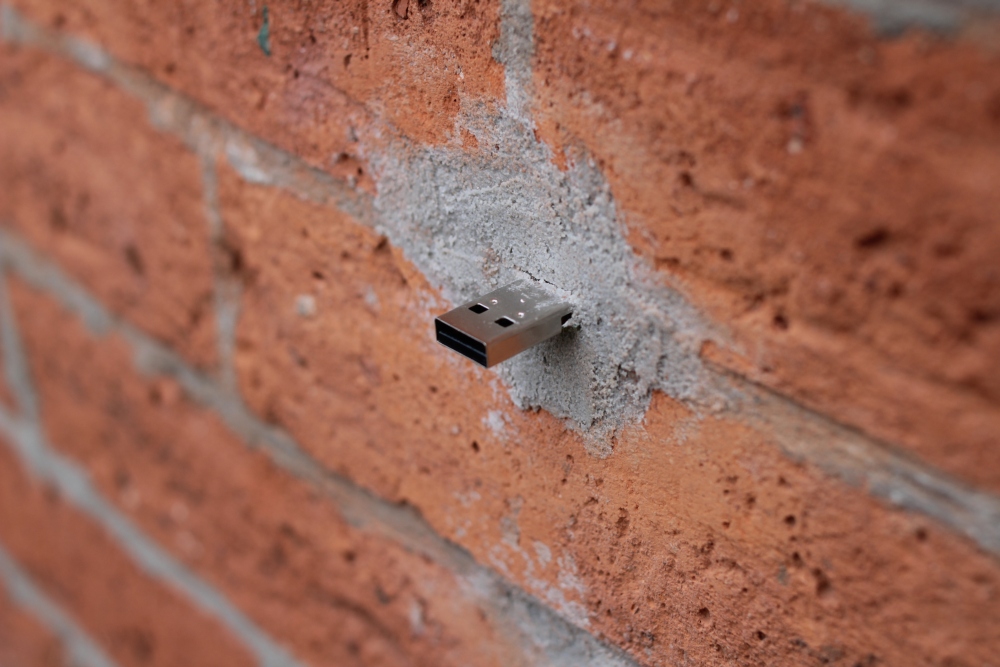Revisiting Dead Drops as Public Anarchival Events
This discussion is a part of a book launch for Imbricate! Press taking place June 30th 2021
 Image Source: https://deaddrops.com/wp-content/uploads/2010/11/deaddrops1.jpg
Image Source: https://deaddrops.com/wp-content/uploads/2010/11/deaddrops1.jpg
In short, this response hopes to engage with the book Affects, Interfaces, and Events as a set of tools that may help in proposing some of my own practices of offline networking and sense-making as a way of staying, to quote from Erin and Brian’s interview, “sensitive to the ways in which we have become habituated to mediating surfaces that promise to lead us where we need to go.”
In thinking of “where we need to go” in relation to mediated surfaces, I would like to start with a broad and tricky question of where do we assume the interfaces of networks are to lead us when we connect, for example, online? My interest applies to those who need to, as Søren Rasmussen states in his chapter, “produce sense from excessive streams of data” but also, I am interested in those who do not have access to and what is afforded to those with access through the engineering of these excessive streams.
Over the past pandemic year, a lot of public and corporate interest has been turned towards accessibility as it relates to internet infrastructure and those needing to work from home. Where I am in Philadelphia, 42% of households in my neighborhood live without a wireless broadband connection. Normative network connections (such as Zoom calls or online classes) are not engineered to lead, or afford, certain populations, to the white, built, wireless faces that often get described as those you would meet in a democratic publics or commons.
While there are efforts to provide cheap, hotspot Wi-Fi for those who need it, there is a serious lack of planned material infrastructure that will sustain for households without any connection. In lieu of this lack of material infrastructure, I would instead like to turn our attention to potential alternative networks that hope to engineer and lead to more democratic, relational, and co-dependent attempts in developing events for connection. Specifically, these alternative networks hope to adopt what in the book speaks of not “technology as solution” but an encouragement of engaging affective and troubling openings for new ways of “re-fielding” technologies of emergent experience, rather than capitalist capture.
As an avenue into potentials for re-fielding the pre-planned and human-centric protocols of the capital “I” internet as we know it, I bring in a hopefully more non-linear way of surfacing, borrowing from Erin and Brian again, an infrafacing with data that might otherwise stay backgrounded. For this, I would like to turn to the online-offline interplay art project and practice of Dead Drops.
Dead Drops are artistic practices that consist of ‘injecting’ a USB flash drive in publicly accessible areas for offline file sharing. What you should see on the screen is what looks like a laptop plugging into a brick wall. There are thousands of injected dead drops all over the world, a database can be found on the website deaddrops.com.
Many are filled with books, movies, music, but also intimate pictures, travel notes, favorite recipes, and art. One Dead Drop recounts that the two young lovers who installed the USB drive will be moving away from each other the next day, and so, on their last day, they injected their own Dead Drop for others to share and explore writing, music, and photos.
The first Dead Drop I had ever visited was a digital exhibit for a gallery in my city. Soaking wet from a spring thunderstorm, I had located the flash drive in an apartment complex vestibule. Struggling to hold my laptop with wet hands, I was eventually able to access various artists works that included images of broken media and videos of playing the performance of someone waiting for a downloaded file. In the exhibit’s own words, they were “compositions anchored in spatiotemporal objects” that related to the experience of using, or put differently, blurring online-offline experiences.
This form of injection through artistic intervention often takes shape through interfacing with a cemented USB stick located in a wall, but they can also be mobile by adding them to buses, taxis, or even more enjoyable ways of interfacing like through the collar of a dog. Here, we are led through unforeseen network routes emerging in real-time where there are missed connections, interfacial events on the fly, chance moments of communication through an animal’s patterns. Dead drops as a network interface find themselves operating as a critical agent in the governmentality that urban planning can implement, through either expanding or limiting affective relations, to reference from Kristine Samson’s chapter on what a city could possibly do.
Within this mix of Do It Yourself urban planning can Dead Drops as a form of critical engineering influence habits, controls, affects? Can they influence planning at all, or will it be subsumed as a neat geocaching game by neoliberal capital? What does emerge are they ways in which transport routes, decaying walls, and unconscious systems are made aware through the ability for users to inject their own contagion of control into the seemingly innocent infrastructure that surrounds us?
Dead Drops in the city present networks of habits that un-cloud moments, present awkward fumblings while pushing metal into brick, and create reimaginings of “democratic transparency.” This potential for change, the potential to “rearrange and re-emerge with different behaviors and sociospatial norms” highlights how much the city inhabitant is influenced by their embedded infrastructure, their embodied memory and habitual networks.
With this in mind, we can reflect on encountering a material Dead Drop as an interfacial event that leads one to take on not just a participatory role in urban planning, but that of caretaker, for the collection as well as the material storage of information itself. One has full autonomy, they can mend the cement, bend the metal, insert, edit, delete, or destroy the device entirely.
What does this kind of network of DIY urban planning afford us? Can Dead Drops create relational events that encourage care? What about them can help bring out and revitalize noise in communication, to reclaim and be with discontinuities and delays, as Søren states, “to create an event with potential beyond the ‘actuality overload’ of too-real-time we would otherwise experience with, say, pings and notifications while walking in the park.”
To offer more questions than answers, in thinking about Dead Drops, what is left behind, what lingers, what is embodied when there is no logging in, there is no cloud, there is no security? To investigate what potentials might linger, I would like to briefly discuss my own experiments in working with Dead Drops.
In May of this year I decided to inject my own Dead Drop and further explore what could be felt, if anything, from these practices. My Dead Drop contained a loose assortment of books, political organizing tools, music I was enjoying that week, and an editable txt file for others to engage with. I found a tunnel near my house that led to the local train station, there I cemented the drive between two bricks and waited.
When I finally did go back to visit the dead drop, I forget how hard it was to hold my phone and my laptop against the wall, plugged in, while leaving traceable markings. I of course still carry with me normative ideals of smoothness, transparency, and seamlessness when it comes to interfacial expectations. Once I connected I see no one has deleted my content, in fact the only thing that has changed is someone had edited the txt file, which was empty other than the title, It is copied and pasted here:
“I won’t read all of it, but the response was exciting. I tried to respond by writing back in the txt file but it was hard, like the anonymous writer said, people look at you, you feel rushed, communication becomes heavy and paranoid. I have gone back but nothing new is updated on the drive, I still wait to engage with remembering and forgetting, with an anarchival play with someone else.”
After this experience I wanted to try and write, produce something that explained the product of the strange communication I was wrapped up in and the unfamiliar temporal longing I had to go back. I referred to the book where ‘signaletic material’ is presented as a tool for thinking about the affective intensities felt in the body and specifically how they relate to the moving image and time. Signaletic material smooths out felt “real-time” through the speed of the normative data transmission we have all become accustomed to. On the other hand, practices of the anarchive, like file sharing, are essential in giving these intensities their own time, as Soren explains in his chapter, there is an opening to consider the temporal moments of waiting. This made me think of the downloading, the walking, the plugging in with Dead Drops. What could be learned from urban design that would consider time in relation to these forgetting, dying, and glitchy elements of technology?
For me, each node, each point in the Dead Drop as network, leads us to potential vulnerable transparencies, risks and paranoia that arise with the digital glory holes. In my experience, I cannot help but feel led to a familiar modulation of control, to follow the orders of the USB, to sit, to wait in the patient temporal process of communicating with the offline network that says, “No, after you.”
With this in mind, the offline experiences could be seen as a “netless” alternative urban space for communication that both bypasses and modifies existing internet infrastructures in order to lead us towards a slow design as it relates to spatial experience attending to and caring for the data. Dead Drops provide a slower shift temporally, a centralized sense of exploration in the speed of the meaning making process that is anarchiving, the forgetting, remembering process.
Reflecting on this, Dead Drops by no means are meant to replace current forms of lacking internet access or to encourage a glitchy, broken form of networking to be put in place for those who need it. Additionally, there is a real security concern with plugging a personal device into a foreign USB drive. These are participatory events that can couse excitement, fear, or terror to the user. These moments with Dead Drops are simply meant to problematize understandings of normative means of interfacing that perpetuate speeds of capitalist capture, those promises to take us where we need to “be.”
The collaborative nature of dead drops plays with old methods of file storage and new rhythms of urban relation that are not anticipated or “pre-programmed,” instead they are tactical and resilient, elusive and destructive, they provide an artistic intervention that at the very least considers an open ethics of offline temporality when we design HCI devices.
What does artistic practice find in the middle, slow moments when staying with the trouble? What do offline practices lend to the digital? Dead Drops as an artistic intervention should be operated as an interface, not as surfaces to exchange files, but as anarchival events that illuminate the in-betweenness of relationality with offline networks, the excitement of biking to the dead drops, the flat tire on the way there, the potential removal of dead drops without my knowing, the poems left on walls (experiences taken from my last visit).
I am still learning and waiting to see if Dead Drops as artistic intervention have any potential to restrict or open avenues of control and power in urban planning. I hope to continue to work with “troubling affective starting points” surrounding this technology, to foster their ability to refuse to neutralize experience by formatting the encounter in advance through the inclusion of coded error, play, and exploration.
